No aircraft, no escorts, no kettles. How much truth can be found in the many myths surrounding HMS Queen Elizabeth and her sister HMS Prince of Wales?
There are scores of myths, rumours and outright nonsense circulating on the internet and even in newspapers about the new Queen Elizabeth class aircraft carriers.
We spend a lot of time pointing out these myths, writing articles about them and directing people to the different articles in an attempt to set the record straight. One of our readers recently asked, ‘Why not just write one article covering the myths?’, so we have.

There’s simply not enough time to discuss or counter everyone of the myths about these vessels so let’s take a look at the most common and resilient myths surrounding HMS Queen Elizabeth and her sister HMS Prince of Wales.

If there’s anything we’ve missed, please let us know!
1. ‘The carriers don’t have any aircraft’
This one even gets repeated by politicians, many of you will be aware of our Twitter campaign to correct this claim across the political spectrum.
Claims the carrier do not have any aircraft are simply incorrect.
Today we mark the historic first #F35 landing on the deck of HMS Queen Elizabeth as a monumental first for the Royal Navy and the Royal Air Force. #F35OnDeck pic.twitter.com/LmtluLUJsP
— Ministry of Defence 🇬🇧 (@DefenceHQ) September 28, 2018
The first jets touched down in 2018.
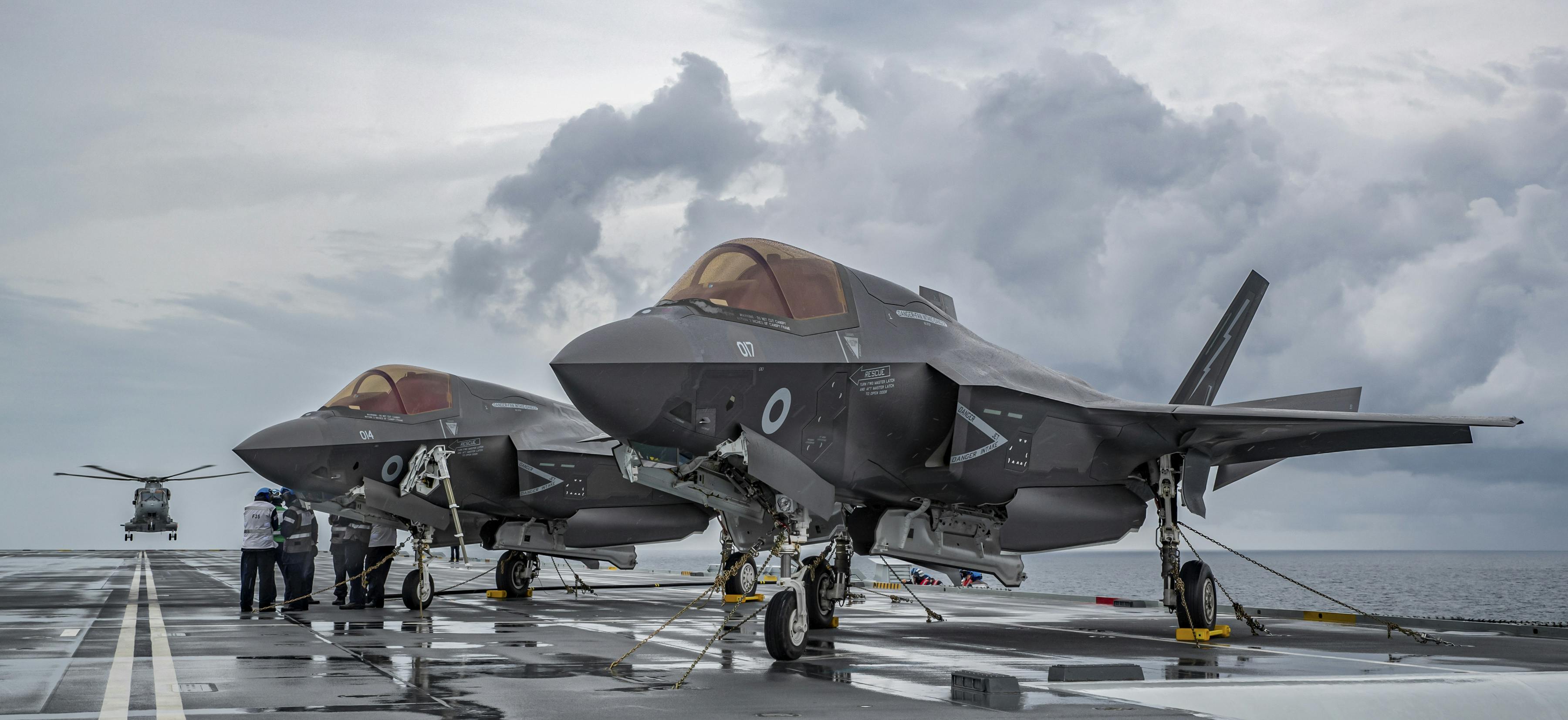
In 2023, the UK will have 42 F-35 aircraft, with 24 being front-line fighters and the remaining 18 will be used for training (at least 5 on the OCU), be in reserve or in maintenance.

2. ‘The computer systems run on Windows XP’.
Confusion on this often brought up myth seems to come from the fact former Defence Secretary Michael Fallon didn’t deny the suggestion the vessels used Windows XP after an image of a laptop appearing to use the operating system (OS) surfaced, the only trouble with this is he doesn’t actually seem to know any better. The Queen Elizabeth class run on the Shared Infrastructure operating system.
Simply put, the system is used in the same way Windows RE is used on commercial machines today, as a recovery and maintenance environment. The use of one operating system in the maintenance of another is not uncommon. XP doesn’t run any systems on-board either carrier.
It should be noted that none of these systems that use XP in this manner are vulnerable to outside attack in the same way the NHS and other organisations were hit. Speculation was rife on this very topic two years ago an image of Windows XP was seen on a technicians laptop during a documentary.
The MoD said:
“The MoD can confirm that Windows XP will not be used by any onboard system when the ship becomes operational, this also applies to HMS Prince of Wales.”
This would appear to agree that XP (or rather, a variant of Windows similar to XP) was being used to test and calibrate the systems by contractors prior to operational service. This is normal.
3. ‘Smaller carriers would have been a better idea’.
Much has been made of the claim two or three smaller ships would be cheaper or more effective than two large carriers but is this really true? The two Queen Elizabeth class carriers can accommodate around twice as many aircraft as the three Invincible class. This metric isn’t the primary advantage of a larger ship class as each F-35B is considerably larger than a Harrier and has much better performance.
There’s very little reason not to build larger carriers, it was once estimated that steel accounted for only about 20 percent of the cost of the ship.
The smaller the carrier, the fewer aircraft it can support and the greater waste of resources it becomes when compared to larger carriers. The smaller the carrier, the more the vessels size restricts the performance of the aircraft onboard. The three Invincible class carriers, which the Queen Elizabeth class will replace, operated small and relatively low performance Sea Harriers. The larger F-35 that will operate from the new carriers is more effective than the Sea Harrier. It carries much more and it flies much faster and much farther. It’s also a more complicated aircraft, requiring more equipment and personnel.
A carrier accommodating as many F-35Bs as the Invincible accommodated Sea Harriers would be far larger by necessity in order to effectively operate the modern, larger aircraft.
The ships former commanding officer, Captain Simon Petitt, rightfully pointed out that there is a lot of symbolism in modern warfare and that having a ship the size of HMS Queen Elizabeth, which will be the navy’s biggest ever, was significant. The sight of a heavily equipped 70,000 tonne carrier, which is almost 300 metres long, heading towards a potential enemy had a deterrent effect that is essential if the UK wants to project influence across the world Petitt claims.
“It is massively visible, you can range back in history and see the value of this. Everything from Nelson deterring Admiral Villeneuve from leaving Cadiz all the way to the big battleships of early 20th century, to what we are doing now. The Americans use it all the time. We currently haven’t got this level of carrier capability. The bigger the capability the more influence you have to bear.”
So great is the impact of larger vessels as a deterrent, they’re often used as a geopolitical chess piece. American governments have, since the second world war, moved aircraft carriers around to demonstrate American resolve.
The particular benefits of using carriers in this way are that they operate on the high seas, where permission is not needed from other countries. Indeed, since modern US carriers are large and imposing they “show the flag” to great effect due to their sheer size alone. Equally, it is often argued that had the Royal Navy had two full sized carriers in 1982 it is more than possible that Argentina would not have attempted to take the Falklands in the first place. Larger carriers don’t have to be packed to bursting point with aircraft to achieve their greatest effectiveness, even with fewer aircraft on board, a ship with a large flight deck can rearm and refuel aircraft much more quickly, this is typically why they allow for much higher sortie generation rates than smaller vessels.
The more crowded the flight deck, the slower the turn-around of each aircraft, the lower the sortie generation rate.
Size also offers greater storage capacity, larger vessels do not have to be resupplied as often, impacting both the effectiveness of the carrier and her vulnerability. Because a carrier is more vulnerable when being replenished, the vessel typically withdraws from station for that function. Much of the time lost is the time spent heading away from station and returning. The smaller the carrier, the more time lost and a bigger logistics chain required in support.
A larger ship is likely to survive damage that will sink or disable a smaller one. The smaller the proportion of a ship that gets damaged, the better the chance that the ship can survive the damage and keep on fighting. It takes sheer size to provide enough protection against all the weapons likely to be used against a carrier, from bombs to cruise missiles to torpedoes.
If a complement of aircraft that would typically be found on one large carrier is split among several smaller carriers, then each vessel needs its own escorts unless they operate together. This would require more resources to operate effectively. It might be argued that splitting up a carrier force would make it more difficult for an enemy to deal with all of it at once but the price paid in escorting ships would be high, making it unfeasible for most navies. Indeed, the most significant effect this would have would be requiring more smaller carriers to do the job of one large vessel, further increasing costs. Each of the smaller carriers in the group is less survivable, more wasteful and less effective than a single larger ship.
4. ‘There are no escort ships to protect her’.
It’s fairly obvious that manning and technical issues with the escort fleet have been causing availability problems but there are still 19 escorts in varying states of readiness.
A senior Royal Navy officer recently insisted that the Royal Navy has enough warships to protect HMS Queen Elizabeth. Rear Admiral Burton, former Commander UK maritime forces, said:
“We have enough frigates and destroyers to protect that task group. We will use coalition frigates and destroyers, but we have enough to deliver a sovereign task group.”
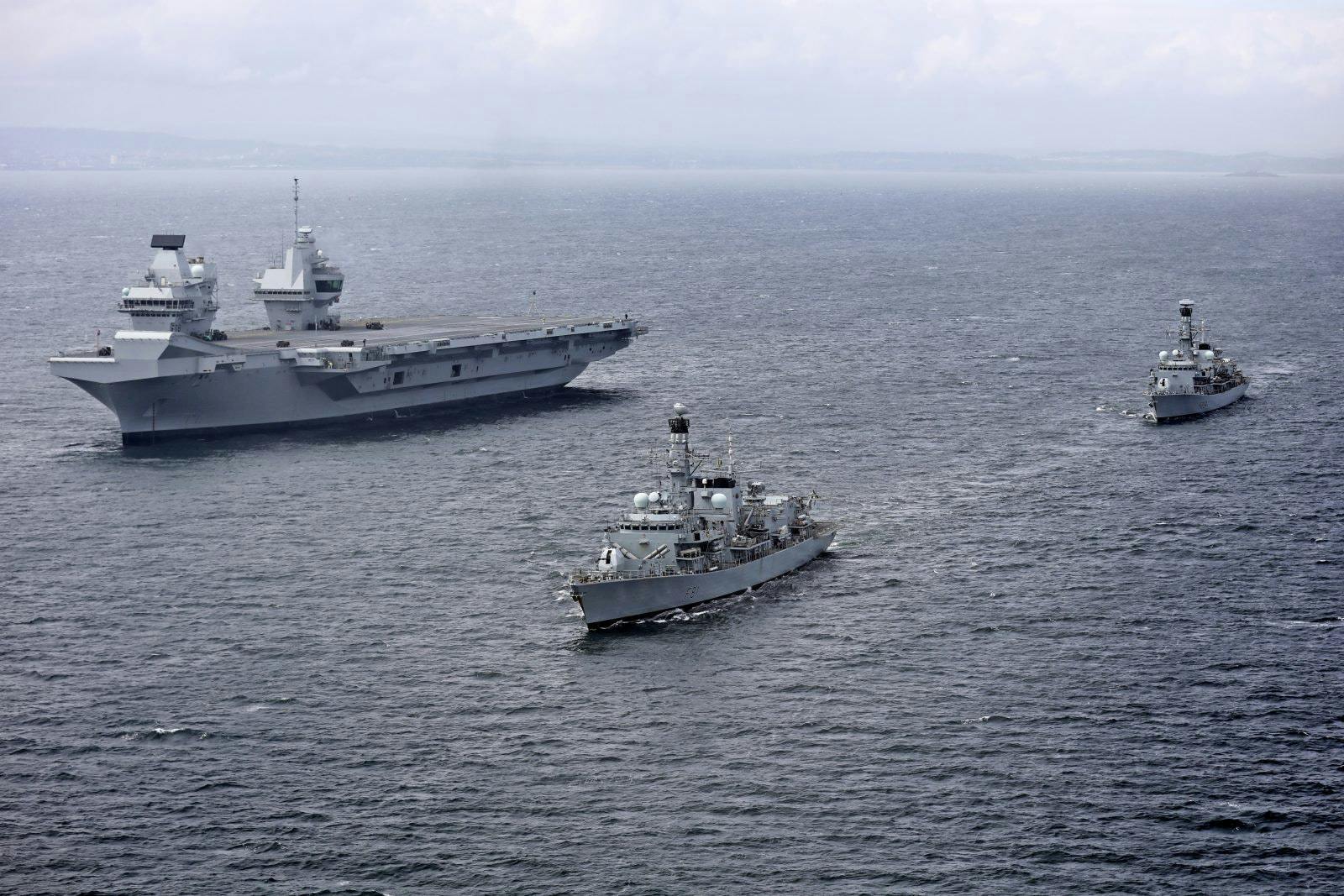
When asked about whether or not the UK has enough escorts to do this without impacting other commitment, Defence Secretary Ben Wallace said:
“The size and the scale of the escort depends on the deployments and the task that the carrier is involved in. If it is a NATO tasking in the north Atlantic, for example, you would expect an international contribution to those types of taskings, in the same way as we sometimes escort the French carrier or American carriers to make up that.
It is definitely our intention, though, that the carrier strike group will be able to be a wholly UK sovereign deployable group. Now, it is probably not necessary to do that every single time we do it, depending on the tasking, but we want to do that and test doing it. Once we have done that, depending on the deployment, of course, we will cut our cloth as required.”
Air Marshal Knighton added:
“The escorts that go with the carrier will depend on the circumstances. The work-up for carrier strike group 21 will be with British ships, because we need to demonstrate and prove that we can do that, but we are already engaged with international partners to understand how we will integrate an Arleigh Burke destroyer from the US or a Dutch destroyer into that package.”
5. ‘One of the ships will be sold/mothballed’.
There are no plans to sell either Queen Elizabeth class ship, zero, nada, zilch. Any suggestion otherwise is pure speculation.
6. ‘The Americans will be the first to use HMS Queen Elizabeth’.
Recently, the Ministry of Defence confirmed plans for the deployment of American F-35 aircraft alongside British jets aboard HMS Queen Elizabeth. However the important thing here is to remember that the US jets will augment the British jets. Not replace them and not operate from them alone.
Captain Jerry Kyd, former commander of HMS Queen Elizabeth, commented on the initial deployment and the gradual increase in air wing numbers:
“We are constrained by the F-35 buy rate even though that was accelerated in SDSR in 2015, so initial operating capability numbers in 2020 are going to be very modest indeed. We will flesh it out with helicopters, and a lot depends on how many USMC F-35s come on our first deployment in 2021. But by 2023, we are committed to 24 UK jets onboard, and after that it’s too far away to say.”
That being said, there are operational British jets onboard HMS Queen Elizabeth right now as I’m writing this.

It is understood that the US aircraft will augment British jets on coalition operations, not replace them and not be the first to fly from the new carriers.
7. ‘The F-35 jets that will fly from the carriers are American’.
The F-35 features a significant amount of British developed components. It’s a multinational effort. As the only Level 1 partner, the United Kingdom has garnered tremendous economic benefits from the F-35. The programme is projected to create and support more than 20,000 jobs across the United Kingdom. Hundreds of British software engineers with BAE have played a leading role in creating software for the F-35 aircraft that will be operational with the US Air Force later this year.
The software team at the BAE site in Samlesbury, Lancashire, has worked alongside Lockheed Martin, the prime contractor on the F-35 programme, to deliver the latest update known as ‘Block 3i’. There are more than eight million lines of code required for full operational capability. Block 3i equips the aircraft with 89% of the software code required.
John Brindle, principal engineer for F-35 Lightning II Development, said:
“Beginning with Jaguar, BAE Systems has a long history and world-class expertise in developing software for aircraft systems. We have made a significant contribution to 3i, including producing software for the fuel management system, on-board vehicle systems, structural health management and elements of the navigation and cockpit display system.”
According to Lockheed Martin:
“The fingerprints of British ingenuity can be found on dozens of the aircrafts key components. BAE Systems, GE Aviation, Martin-Baker, SELEX, Cobham, Ultra Electronics, UTC Actuation Systems and Rolls-Royce are just a few of the more than 100 U.K.-based suppliers for the programme.”
8. ‘The ships were only built to benefit Scottish yards and have no strategic purpose’.
There were 3,000 people in Rosyth, with another 8,000 people working at sites around Scotland, England, Wales and Northern Ireland were involved in everything from building segments of the hull to parts of the systems installed on the ships. Then there’s the wider supply chain network, involving hundreds of companies around the UK. In short, the jobs created and the effort going into this new British built icon are unprecedented for a single project in the 21st century.
The origins of the massive and sometimes controversial Queen Elizabeth class carrier programme lie in the 1998 Strategic Defence Review. The review re-evaluated every weapon system (active or in procurement) with the exception of the Eurofighter Typhoon and the Vanguard-class ballistic missile submarines.
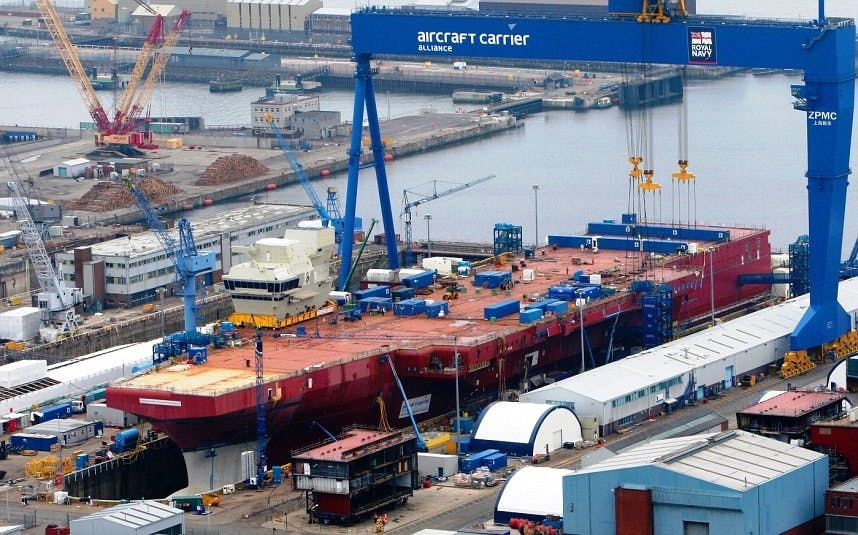
The report identified that aircraft carriers offered the following:
- Ability to operate offensive aircraft abroad when foreign basing may be denied.
- All required space and infrastructure; where foreign bases are available they are not always available early in a conflict and infrastructure is often lacking.
- A coercive and deterrent effect when deployed to a trouble spot.
The report concluded:
“The emphasis is now on increased offensive air power, and an ability to operate the largest possible range of aircraft in the widest possible range of roles. When the current carrier force reaches the end of its planned life, we plan to replace it with two larger vessels.”
In November 2004, while giving evidence to the House of Commons Defence Committee, First Sea Lord Admiral Sir Alan West explained that the sortie rate and interoperability with the United States Navy were factors in deciding on the size of the carriers and the composition of the carriers’ air-wings:
“The reason that we have arrived at what we have arrived at is because to do the initial strike package, that deep strike package, we have done really quite detailed calculations and we have come out with the figure of 36 joint strike fighters, and that is what has driven the size of it, and that is to be able to deliver the weight of effort that you need for these operations that we are planning in the future.”
9. ‘Nuclear power would have been better’.
Cost is single-handedly the most prohibitive reason the Queen Elizabeth class are not nuclear powered. More conservative estimates say a reactor adds 280% to the lifetime costs of a ship. Aircraft carriers typically only carry a month’s worth of aviation fuel, including US and French nuclear vessels, so need to be refuelled monthly anyway. There’s no real operational advantage to having the vessels nuclear powered, especially when weighed against the massive increase in costs.

Tide Class tankers, of which RFA Tidespring is the first, are replacing the RFA’s current, ageing single-hulled tankers.
For more on why nuclear power doesn’t make much sense for the new carriers, I fully recommend ‘The reasons HMS Queen Elizabeth is not nuclear powered‘ by savetheroyalnavy.org.
10. ‘She is named after the current Queen Elizabeth’.
The name HMS Queen Elizabeth is a continuation of an historic Royal Navy name dating back over a century and the vessel herself is not named after the current monarch.

10. ‘She leaks!’.
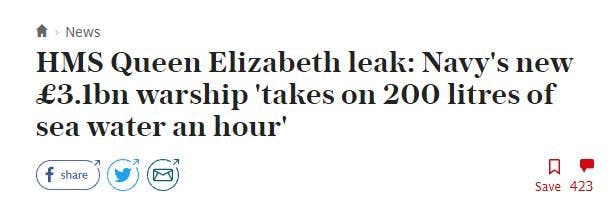 The HMS Queen Elizabeth made headlines last year when a leak was discovered on board. Issues like this occur often on vessels of all types, especially during a phase of their life designed to identify and rectify faults. A minor leak on a ship is not a serious concern, in fact it’s very common.
The HMS Queen Elizabeth made headlines last year when a leak was discovered on board. Issues like this occur often on vessels of all types, especially during a phase of their life designed to identify and rectify faults. A minor leak on a ship is not a serious concern, in fact it’s very common.
This happened during the ships sea trials, a stage of her life designed to find and resolve issues.
While some argue that this is a major issue it should be noted that the Royal Navy themselves seemed confident that it would not impact the schedule of the vessel and they were correct. We spoke to someone serving on board the vessel via e-mail, he told us under the condition of anonymity:
“We’re bemused, nothing more nothing less. This so called issue isn’t a new thing and it’s not what I would call serious. It’s disappointing to see how easily this has been blown out of proportion.”
A Royal Navy spokesman said:
“An issue with a shaft seal has been identified during HMS Queen Elizabeth’s sea trials; this is scheduled for repair while she is alongside at Portsmouth. It does not prevent her from sailing again and her sea trials programme will not be affected.”
The Sun says that HMS Queen Elizabeth has been taking on up to 200 litres of sea water every hour.
“A faulty seal around one of the vast warship’s propeller shafts means 200 litres of sea water pour in every hour.”
A typical bilge pump even on a narrow boat, by the way, can handle over 1000 litres per hour.
Admiral Chris Parry told Sky News the leak was a non-issue:
“Every ship, to tell you the truth, takes on water that’s why you have pumps. What people have to realise is the whole reason for sea trials is that you race and rally the ship, you stress it right to its extremes, and you’re really looking for faults like this to see what happens.
You get this all the time, you’ve got very complicated engineering under the water, it’s operating obviously at sea and every yachtsman will tell you they take in water somewhere, that’s what you’ve got pumps for, that’s why you have dedicated engineers, it really is no big deal I have to tell you.”
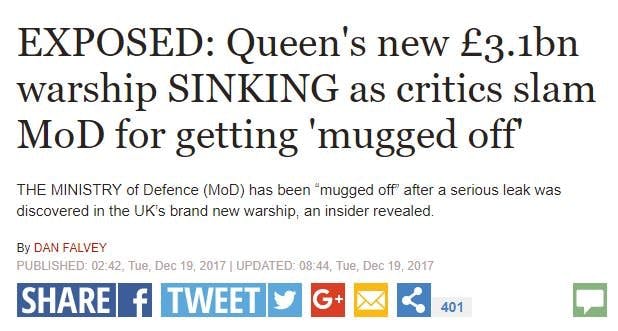
The ThinPinstripedLine response to the story about the ‘leak’ can be found here and summarises today’s events very well.
“The issue affecting QUEEN ELIZABETH seems extremely minor, easily fixable and not remotely in the same league of problems that other ships have had. It is a testament to the quality of British shipbuilding skill, and the strength of the CVF design that she has come through trials with only very minor problems.
The battle for the Royal Navy though is pushing this narrative against a media determined to make a minor technical problem into a major PR disaster for the Navy. In the public mindset the front page news today will help set the narrative for the ships early life, regardless of how utterly untrue it is.
Part of this stems from a lack of understanding on the purpose of sea trials, or that faults will occur, but that they are easily fixable. It also stems from the problem that as papers have scrapped their specialist journalists, the days when deep experts like Desmond Wettern could be relied on to provide deep knowledge and understanding, spotting when an issue was a non-event, or equally when what the RN wanted to make out was a non-event was actually a scoop are long gone.”
The shaft seal issue was identified during trials and seemingly was not deemed serious enough to delay subsequent activities. While obviously this is an issue, it’s not a major issue as the 200 litres an hour will easily be handled by the ships pumps until the issue is resolved, which it will be before she sails. To put it in perspective, that’s around two bath tubs of water.


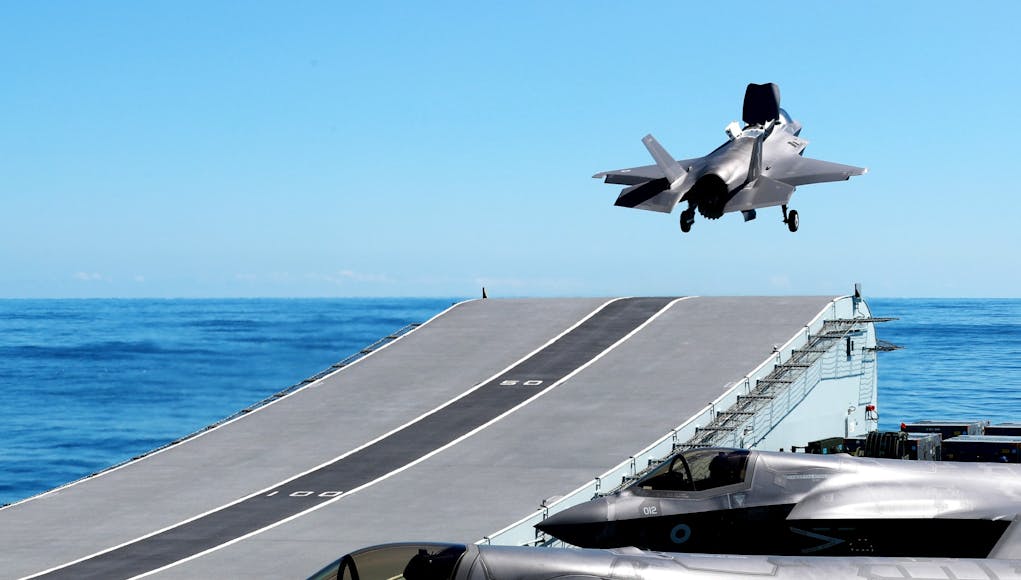

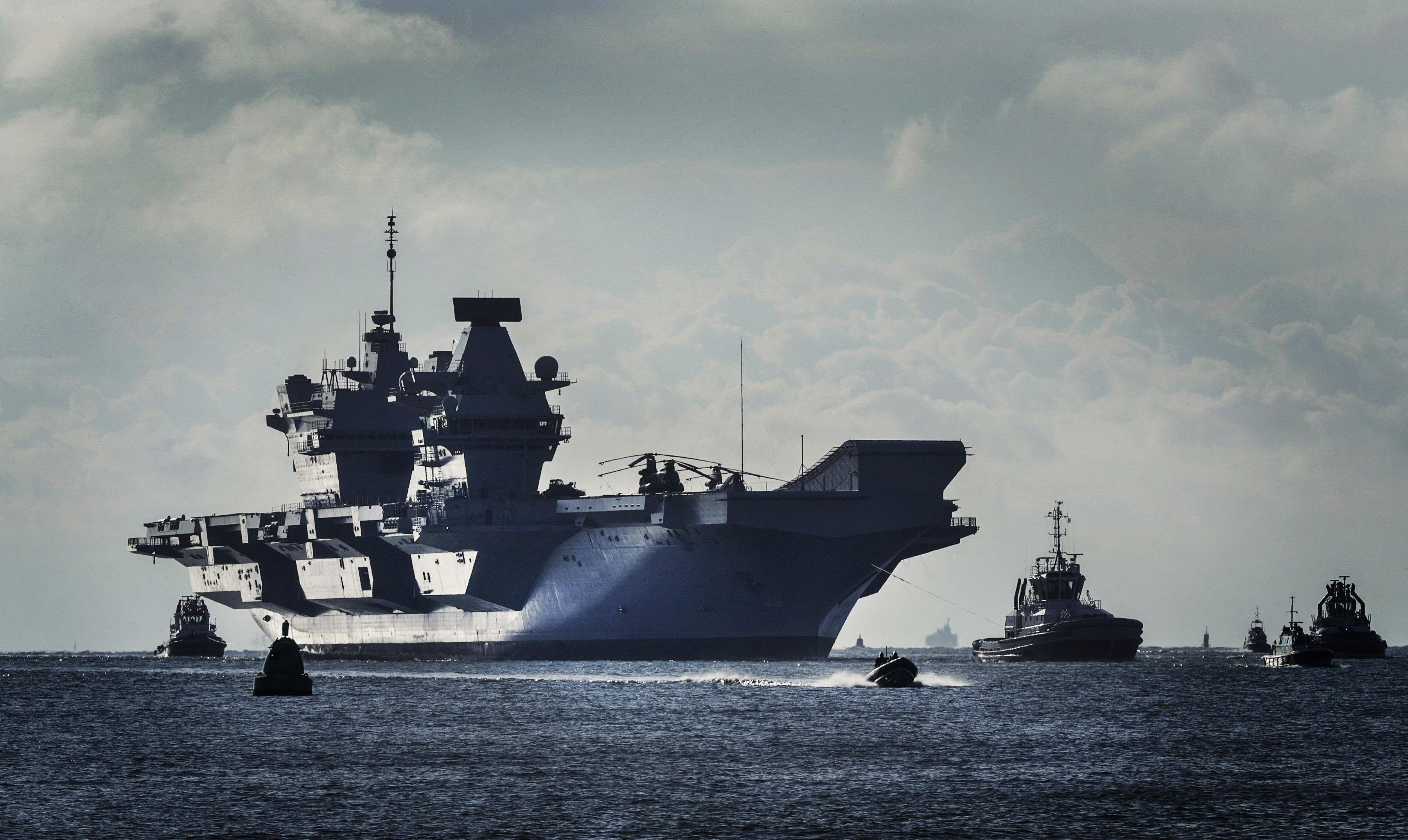
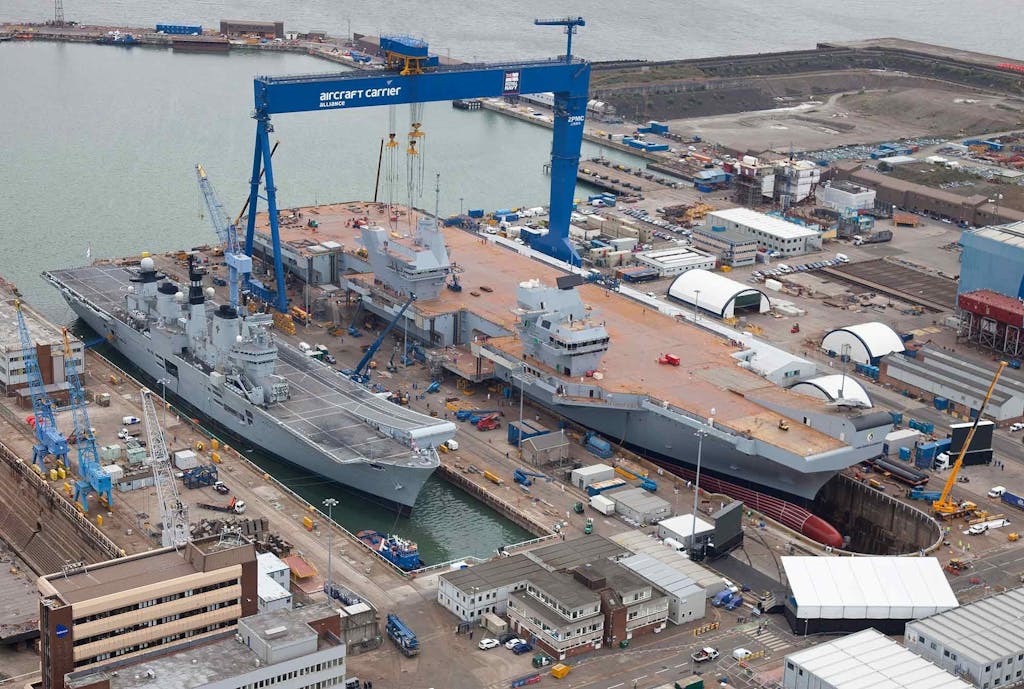
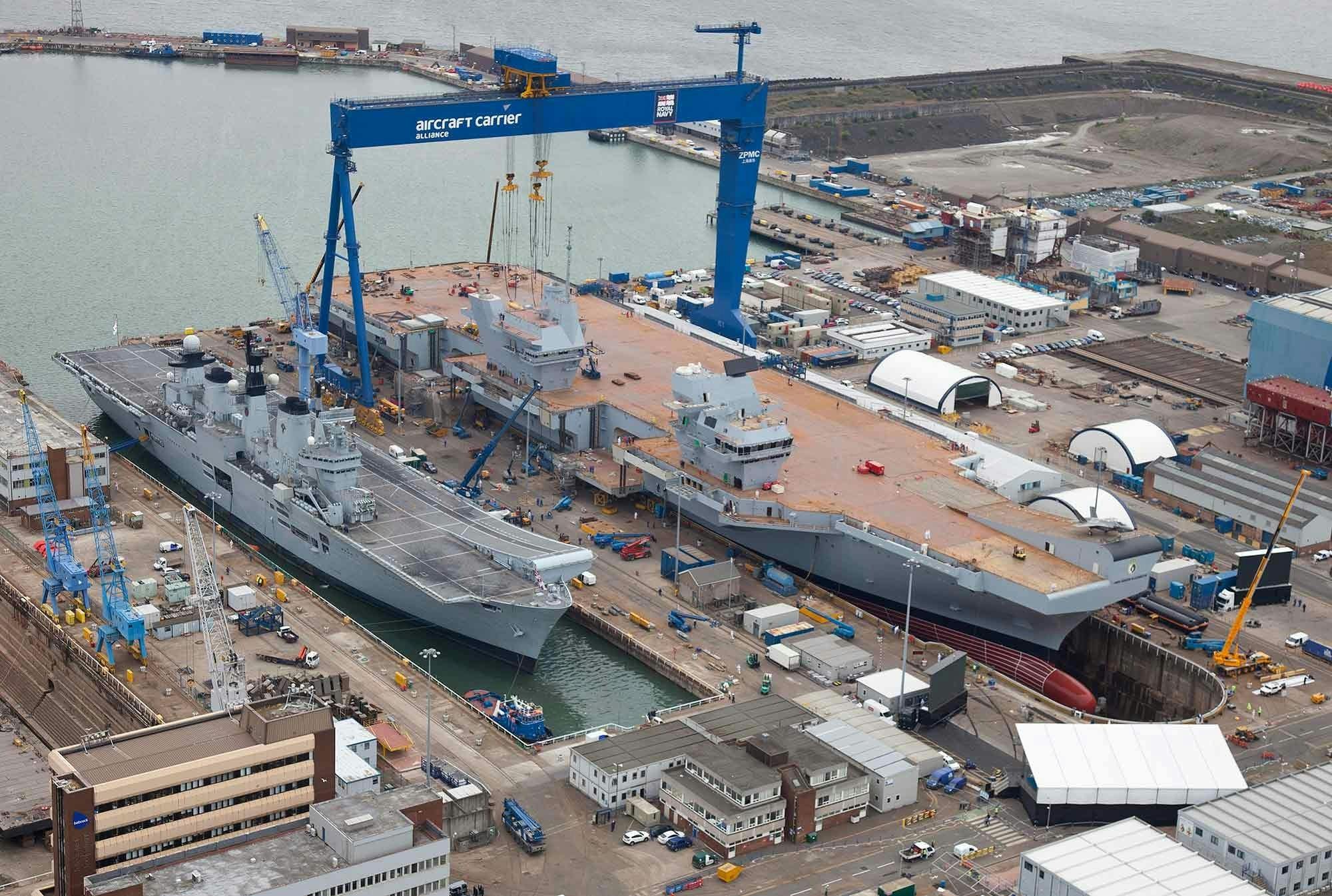
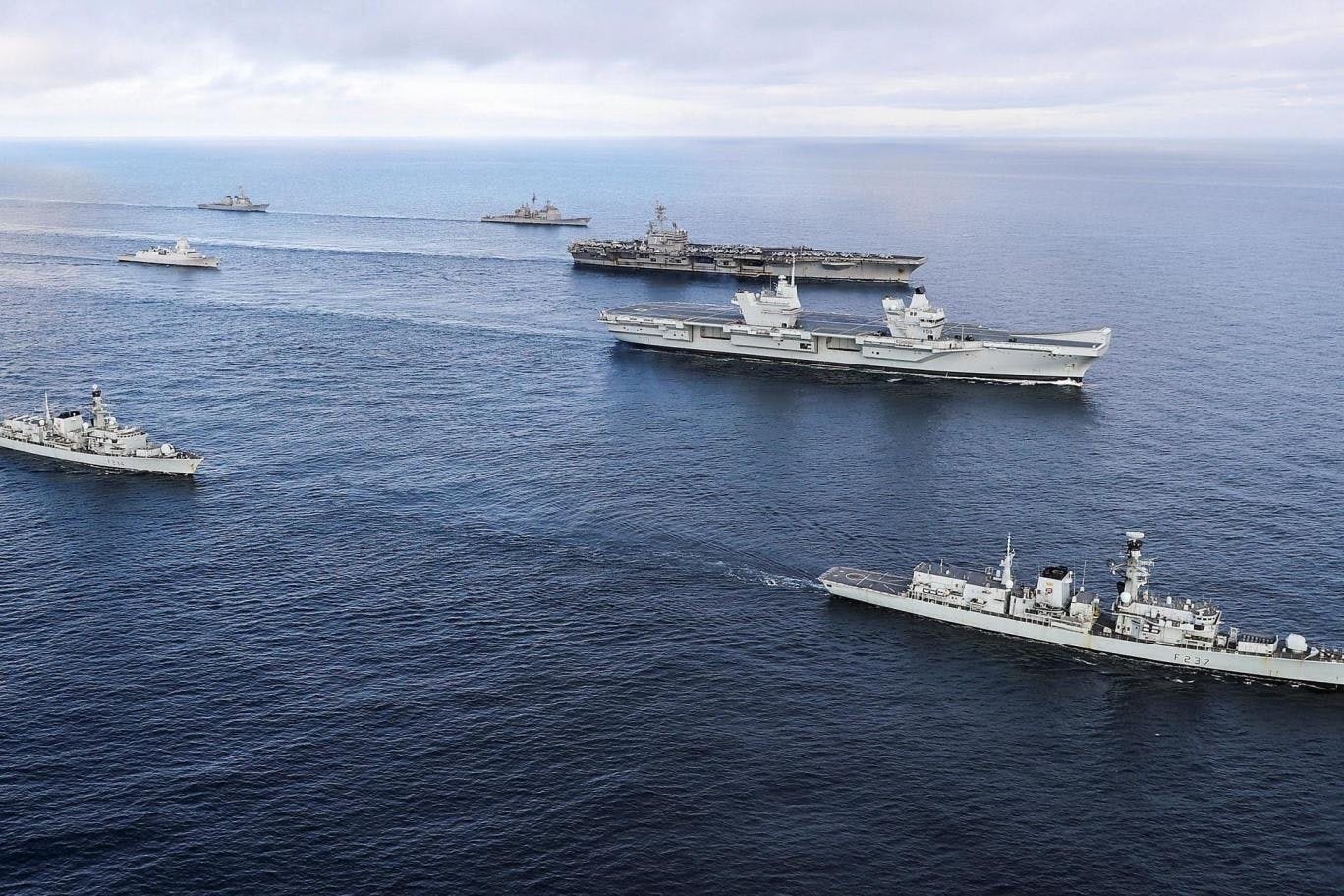
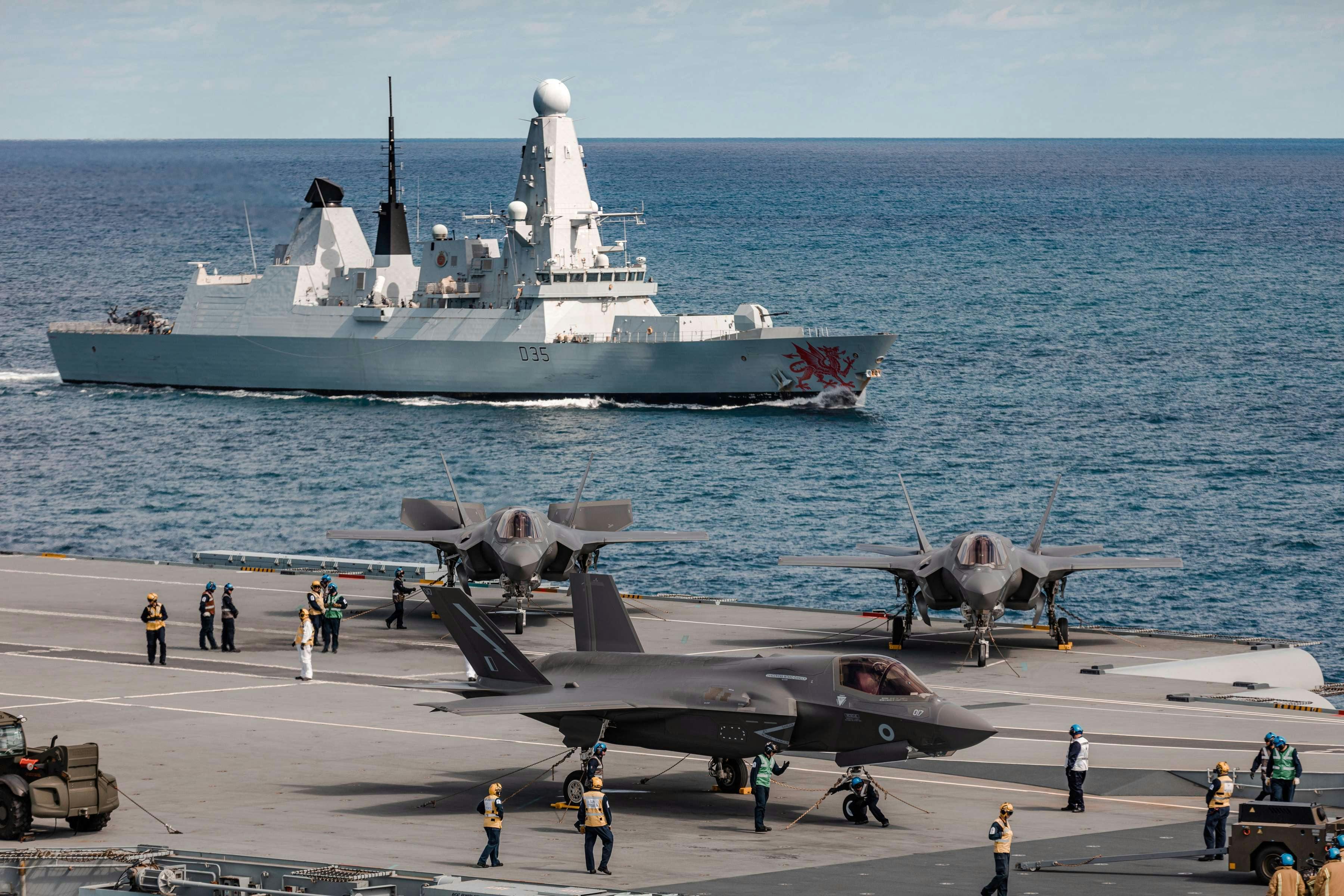




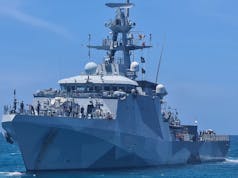
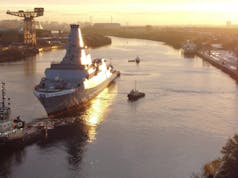
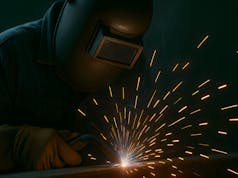
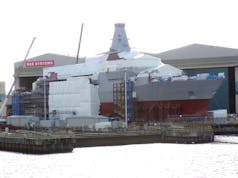




A great idea to write this summary article. I am annoyed and dumfounded by the idiotic hoaxers who propagate these falsehoods. Lock them up and throw away the key. (Yup just lock them ALL in the same room, dark other than a webcam of the deck of HMSQE)
It’s so frustrating how putting the country ( and these ships and the armed forces in general ) down seems to be in the DNA of so many people.
Did something go wrong in their education? They cannot see the wood from the trees as to what assets these vessels are to the UK, the RN, and the UK military.
I think it’s a combination of a few factors:
1). Some people hate the armed forces in general. They want to live in an ‘ideal world’, where everybody loves each other, we all get on, and war is but a thing of the past. I hate to burst their bubble, but that ain’t gonna happen. Certain individuals, terrorist groups and rouge states pose a very real threat to our war of life, and they’d simply have a field day if we disbanded the military.
Coupled with this, people don’t realise how versatile certain military assets can be – particularly ships. They can engage in search and rescue, provide a centre for diplomatic events, or provide humanitarian relief to people of any class, colour or creed pretty much anywhere in the world. Their soft power potential cannot be understated. These are the very activities these individuals (those who disapprove of the military) want us to engage in, so I do question WHY they’re so against us having assets which can facilitate this.
2). Perhaps the most prevalent reason is that people simply cannot grasp how long it takes to procure equipment, learn how to use it, train people how to use it and ensure it can operate with current assets. It sounds simple doesn’t it? Build a carrier with a flat deck, and land a Merlin on it. Sure, the act of the landing is relatively simple to a trained and experienced crew, but it’s everything that comes WITH that that takes time. How will the aircraft behave? How will weather conditions affect it? How will operating in proximity to other ships and aircraft impact operations?
3). The press doesn’t really help in stirring things up. I’m talking about the papers who think we still use battleships, that a five inch gun refers to its length, and the sort who post a picture of a Typhoon and claim it’s an F35 or something. We all know the type. Christ, even ‘Cornwall Live’ loves to run clickbait stories about FAA helicopters operating in the county. Royal Navy helicopters, in Cornwall?!?! A county that’s host to one of two Naval Air Stations?!? A county that hosts many other naval activities and sits next to Devonport, an ASW hub?!?! Shock horror!
Their sensational stories (such as the leak) become rooted in people’s mindsets; discussed on social media or around a table in the pub. It’s very hard to adjust that, particularly if people have no idea how the military operates or how it uses its assets. Perhaps if articles were presented in a well thought out way, with at least a basic amount of research, people would be less quick to complain. Government statistics on escort/airframe numbers can be accessed by anyone, as can historical data if you wish to compare these numbers throughout history.
I guess these individuals also fail to read multiple sources to come to a balanced conclusion. Either they skipped that bit in school, or their intellect doesn’t go above a scan of the Daily Fail.
4). I guess some of this comes down to us too. Perhaps people ‘in the know’ or those who have some knowledge of defence matters are too quick to judge. We should use people’s comments as an excuse to educate, rather than berate them. With that said, I do think some of the comments are taken out of context: some are purely humourous/satirical, but these are in the minority.
I didn’t mean for this to be so long, I just wanted to offer some thoughts off the top of my head. I think the bottom line is, some of us agree with some of these comments to an extent – I’m sure we would all like to see an increase in escort numbers, airframes and the speed in which we reach IOC. But we at least understand the ‘wider picture’ and why some of these things aren’t possible/achievable right now. I wish people would focus on these amazing assets and the fantastic people that operate them, rather than drag them down at every opportunity. Bloody beautiful ships and a real credit to the UK.
Thanks, chap. I’m a simple man, I see a bit of the Grey Funnel Line, and I click!
(And I also like to defend it at all times!)
All good points. I do feel that the end of the Cold War and the controversial interventions in Iraq, Afghanistan and Libya have resulted in the armed forces being viewed in a less positive and often cynical light in some quarters. There is sometimes a simplistic view of defence that demands a specific and tangible threat in order to justify continued investment, e.g. the Soviet Union. Several times I have been asked by friends and colleagues, ‘What exactly are we defending against?’
What the public and media often fail to appreciate is that defence is a key element of international statesmanship and a ‘long game’. Global security and the ability to shape the global strategic space are in our national interest regardless of whether there is a clear and current threat or not. Things can change quickly and in an unpredictable way so we have to be prepared. Trying to convince others of this however is problematic when World War 2 is barely within living memory now and the Cold War ended 30 years ago.
“Cold War ended 30 years ago.”
Damn I feel old!
Hi Lusty,
Two things that really stood out for me:
“Perhaps people ‘in the know’ or those who have some knowledge of defence matters are too quick to judge. We should use people’s comments as an excuse to educate, rather than berate them.”
That is well said and for once demonstrates someone suggesting they and others take on some responsibility. I think part of the problem is that everyone thinks in terms of ‘rights’, but for every ‘right’ there is at least one responsibility. Perhaps part of our responsible participation in the debate is to offer educated and measured responses to inaccurate or flawed statements where we can. Nicely said, sir!
“amazing assets and the fantastic people that operate them”, nuff said!
Nice post, thanks
CR
Thanks, CR. It’s always a pleasure to read your posts and arguments.
I fully agree!
In fairness, building a couple of hoofing big carriers was a bit of a shift in policy. I can understand why some are against it, they’re designed to head off to ‘other places’ and get Johnny Foreigner ‘telt’. That’s not everyone’s bag so I can get why some aren’t so keen.
Saying that, I agree with most of what Lusty says below (maybe, the stacking system on here can be a bit erratic) and especially the bit about the media, they’ll do anything for a story. Some are shameless in that regard on a range of subjects.
I’m largely ambivalent to UK defence policy in that regard, if we want to deploy a carrier group or two then cool, we need to pay for it though (looking less and less likely currently). If we want to pull our heads in and concentrate on things closer to home then I’m cool with that too. Whichever way we go, it needs to be funded properly.
It does, or ought to, move us to a much more (I would say completely more) maritime strategy. It gives the army a clear secondary role led by special and elite forces.
The capabilities of the F35 (on top of the Typhoon) also extend our military capacity and strategic reach.
So, we are now playing ‘blame the teachers’?
Nope. If I was blaming teachers I would have said teachers Rob.
Both vessels are a showcase to the world at how bloody fantastic British design , engineering and knowhow is. Alas the minority of doomsday merchants and constant complainers only do so because they were picked on at school and had difficulty with social interaction.
U.K. plc and armed forces simply the best ???????????
Well lets start.
Whether to have 3x 35000 ton STOVL Super Invincibles or 2x 70000 ton carriers is a perfectly valid question. Too late to change anything now though.
If you go for 70000 tons, then you should have gone for CTOL. People rant about sortie numbers, but they are pointless if your short legged STOVL fighter cannot reach the enemy. Granted EMALS & AAG were troubled in 2010-12, but they are pretty much sorted now.
We need to make the best of where we are. So some V-22 for air refuelling & on board delivery. Before the production line shuts.
Some sort of heavy stand off weapon for F-35B. If Spice 1000 fits the internal bays, it might be a good option. Spear 3 will be too light for some targets.
Escorts, the numbers & their fitness to fight, is a real ongoing issue, that cannot be swept under the carpet.
Look, I love big carriers & am glad the RN has 2, but lets not be complacent. There is work still to be done to make the most out of them.
The F35B has comparable combat range to a super hornet, so they are far from short legged. EMALS would have cost billions to install and millions more to fix. Just 5 days ago the US DoD had reported of problems with the Ford’s catapult system. It’s not fixed yet.
I agree with the air launched AShM capability, 10 years is far too large a gap to wait without one.
The V22 is extremely expensive, more so than an F35. Would it be more sensible to invest in the new V280 Valor? Or, if the money were there an entirely new LPH to replace Argus?
Regarding AshM the issue is one of availability of suitable missiles and then availability on the F35 platform. The LRASM (OASuW Increment 1/1.1) is the main candidate for a modern AShM missile available today, which the USN is qualifying on Super Hornets, B1-B, and P-8s. At this point it doesn’t look like it will be qualified for F-35. Instead OASuW Increment 2, planned for IOC in the 2028-30 timeframe, is the more likely candidate, assuming the USN don’t go with JSM. The USN can use F-18 as LRASM missile trucks with F-35C as the targeting platform, so no compelling driver for them to add LRASM to F-35.
What will be added to F-35 is SPEAR 3 and JSM for light and medium AShM capability, both come in Block 4 IIRC so mid-2020s capability. The UK is committed to SPEAR 3 already and might optionally take on JSM (wing loading only for F-35B), given Australia and Norway are paying for the integration. I thought I had read that Japan might be interested in a version of JSM with F35B weapons bay fit, but that seems a bit speculative. For a heavy air launched AShM capability the UK would then look to FC/ASW early 2030’s which you alluded to.
V-22 is expensive and becomes very expensive if used for AEW, COD and tanker duties. While V-280 might be a future option, I could also see commercial hybrid eVTOL development delivering a military option. Rolls Royce seem to be quite invested in this future, using gas turbines to generate electric power for lift fans on tilting wings.
https://www.rolls-royce.com/media/our-stories/discover/2018/blue-sky-thinking-rr-unveils-evtol-concept-at-farnborough-airshow.aspx
V280, much better idea.
Cheaper and safer because they don’t revolve the turbo props.
License build them here too, make local in flight refueling model and an AWACS model.
Well the Americans are having a debate about whether the short legs of the SuperHornet means their supercarriers have to go too close to the enemy, making them vulnerable to the new anti ship missiles. The SuperHornet replacement is likely to have much greater range, possibly unmanned, though that is still to be decided.
Is Emals sorted now? Wasn’t it one of the main reasons for the delays and cost over runs to the Ford class. The technology wasn’t mature enough for the RN we didn’t have the money to throw the dice. Who knows in 25 years we can always install one or two if we want to operate large UAVs like the USN.
There are some very important pros that come with operating STOVL carriers that people never discuss.
First and most important.
A STOVL jet lands first time, every time.
This means they don’t have to reserve much fuel.
In the Falklands they could push the range and come back on fumes
Landing is simple and safe, no cats to fail, no need for and angled deck, no need to clear the deck.
The F14 required literally tonnes of fuel to be reserved for when they had to make go arounds.
And then you needed even more fuel while you waited for the key in front of you to finish landing
And then you needed YET MORE FUEL because you’re in a heavily reinforced aircraft to survive the repeated crashes into the carrier. Yes, they don’t land, it’s a controlled crash.
STOVLs don’t need that, come down like a butterfly landing
I’m the Falklands, at night less in bad visibility they just chucked flares off the stern to guide the harriers in, low tech, simple, works.
Catobar? Yet more fuel needed for tricky instrument landings. Andall the ILS gear on the boat. Has that broken down? Whoops, no sorties for you
Barrier wires brown? No sorties
Last wire broken?
£100 million jet crashes in sea
Cat failure? Jet in sea.
And with rolling vertical landing, no more ditched munitions
These guys aren’t stupid, there are good reasons to operate stovl carriers
A point well made Roboj1m
Then why does the USN & France do CTOL? Are they idiots? Why does China crave to join the CTOL club?
With the extra range of CTOL aircraft, the carrier has a bit more flexibility to find a patch of calmer sea. Something the short range of STOVL does not allow.
In the case of France and US I’d say history. Meaning Harrier was the only STOVL solution and it wasn’t capable enough compared to CTOL aircraft. F35B vs F-18/F35C narrows that gap considerably. STOVL does currently have trade offs in terms of AEW and tanker capability, but not insurmountable. The US may be touting the need for greater aircraft range to get the carrier beyond anti-ship missiles but the reality is the carriers will always be within the range of future manoeuvring ballistic missiles.
China doesn’t have an F35B proxy, so it has to go CTOL since STOBAR won’t cut it.
STOVL can operate in rougher seas, from a damaged carrier including one stopped in the water, without any wind assistance. This is not a trivial benefit in a future where carriers are under far greater threat than in the past 75 years.
F-35B limited to 1000lb class weapons. F-35C can take 2000lb class weapons. F-35C has an extra 200 nm mile range, as it is not lugging an extra 1800 kg of two stage fan, clutch, drive shaft, roll posts, fan & swivel nozzles & clamshell doors.
Your weapons limit is for internal carriage. No reason why a clean F-35B can’t provide targeting for wing loaded F-35Bs, the latter being beyond and/or below the radar horizon. Using clean aircraft for targeting might be more desirable anyway, versus exposure when opening the weapons bay. F-35C extra range comes from additional internal fuel capacity due to lack of the equipment you list, not weight advantage. The empty weight of F-35C is actually ~2,500 lbs heavier than F-35B. Regardless these observation don’t negate points made by myself or others.
The RAF has no longer any 2000lb bombs in it’s inventory.
Even the tactical nuclear warpons
the RAF once had, and scraped in 1998, were under a 1000lb in weight.
Remember that the USN actually operates CATOBAR and STOVL aircraft carriers…
I would say John, had the option of a 30,000 ton design been taken, there would never have three, two would have been the maximum number.
CTOL is extremely limiting and expensive for nations that can only afford to run one or two carriers.
Aircrew have to remain current, it’s an ongoing nightmare for the French, trying to keep sufficient pilots Carrier qualified.
In there current configuration, our duty carrier will be able to maintain (and generate new where needed) carrier qualified fast jet pilots extremely quickly and thus respond to a crisis much faster, surging additional aircraft and aircrew quickly.
It simply allows far greater flexibility for our Navy.
I would love to see a version of the beefed up USN COD V22’s in the RN, with removable AAR capability.
They would add considerable flexibility, in bringing supplies from shore and close the fast jet range gap between STOVOL and CTOL operations.
A massive force multiplier, but out of our budget….
A brand new CMV-22 with initial spares package is $105 million. Can we really not afford 4?
It would be truly wonderful to see John, a true force multiplier.
The US Navy Spec COD version would be a perfect fit for the RN, able to deliver spare F35 engines and etc directly to the carrier.
I would have thought an order for 12 would be needed, allowing for 5 on the active carrier (Cod and AAR), plus maintenance, training and reserve examples ashore.
It would open another interesting avenue for reinstating the AAR capability of the Merlin HC4 and SF Chinooks, plus obviously the F35B .
It could even lend itself to AEW, with the system lowered and raised through a modified rear ramp aperture, as originally envisioned.
Adding AEW would obviously mean a further uplift from 12 airframes.
So when the carrier is operating in its Commando role, it would allow SF raids over a much greater distance.
But imagine an asset that could be re-roled from COD, AAR and AEW as needed.
What a piece of kit that would be…
I don’t think the Valor is the right option as a tanker aircraft. The reason for this is that it doesn’t have a ramp and only side doors. I suppose you could still have the drogue reel in the cabin and route it to the wing so it turns 90 degrees backwards. But mostly because it’s much smaller than the V22.
The main advantage the Valor has over the V22, is that it has been 40 years from when the JVX program was first initiated and technology has moved on a lot since then. The Valor is a much simpler design and being completely designed from 3D modelling. The Valor has a payload of 12,000lbs (5400Kgs), whilst the V22 can carry 20,000 lb (9,070 kg) of cargo. Which isn’t bad for an aircraft replacing the similarly sized Blackhawk that can carry 9,000 lb (4,100 kg) externally and only 2,640 lb (1,200 kg) internally.
The Valor has a proportionally longer wing and larger prop disc than the V22, making it more efficient when cruising and when in the hover. They have also made the aircraft from a larger amount of composites, which is great for lowering your production costs and the aircraft’s empty weight, but crap for repairing. Unless they have a cunning plan for battle damage repairs? Perhaps it’s time Bell looked at updating the design of the V22 with what’s been developed for the Valor?
The options were 2 small carriers or 2 large carriers. I suspect that even with the small carriers they would have struggled to come up with a credible design under 40,000 tons. The QE class may be a compromise but they were the best design the RN could get whilst remaining affordable. CTOL would have been too expensive and run the very real risk of the whole project unraveling, leaving the RN with nothing at all.
I go along with all that’s said here bar the naming, it’s quite clear that though they may argue the toss as much as they like the chosing of those two names were influenced by the Queen and her son. I just don’t think coincidences of this nature happen very often, it’s just in this case it can be deniable for whatever reason.
Lol i had not heard of most of these rumours. The QE class carriers are a definite step up from the previous class. Even the F35B is much more capable than the Harrier.
However my biggest criticism is the lack of CATOBAR, this greatly increase a carriers capability with deeper strike missions and more flexibility on the type of aircraft that can be deployed. (not being dependent on F35B only which is not delivering on expectations and more importantly no Hawkeye E2D or buddy refuel capability). STOBAR is still better than nothing, but still a missed opportunity. Since these ships will operate for the next 50 years, I truly believe CATOBAR config equipped with a mix of Hawkeye E2D, and F35C would have been worth the costs. You could even operate a mix of F35C and F18 SH for most missions which do not require stealth. The F18 SH is more than capable at a fraction of the F35’s operating costs. IMHO passive stealth has limited viability in the long run since a variety of sensors are continualy improving their detection range of stealth, so putting all your eggs in one basket on a passive stealth airframe for next 50 years is naive at best.
Finally the F35C could be used by the RAF to replace the Tornados, and could be used by the RN in case of force majeure. That way no need to operate F35B and F35A. The F35C has the greatest range of all 3 F35 variants so best suited for deep strike missions 😉 leaving Typhoon for interception and air supremacy.
My 2 cents
CATOBAR has its issues too, mind.
The sortie rate will be lower and CATOBAR launches are more susceptible to weather. Not to mention the costs of operating and maintenance vs a ramp, which is essentially a hunk of metal and needs none.
Catapults, be they steam or EMALS, require more people to operate them. The US carriers have huge ship’s complements compared to the QEs.
We may well have to convert them to CATOBAR in future, using EMALS, but if so not for at least 20 years. Right now we don’t know what would replace the F35s in future. They’ve barely become operational so chances are no one will be even thinking of that for at least 10 years. We may convert the QEs during a midlife refit in 20-30 years, depending on what could replace the F35s. If there is a STOVL aircraft in the pipeline then no need to.
Sortie rates are much higher on Catobar carriers since US carriers have 4 cats, whereas the QE only has 1 ramp. US Ford class can do sustained 160 sorties per day and can surge to 270! Obviously maintenance costs are higher, but a carrier is a military expenditure which gives unique capability. Cost is not the most important metric in terms of a nation’s military.
I wonder if the higher sortie rate of CATOBAR actually works out in practice though. Sure US carriers have 4 cats so they can get a lot of aircraft up fast if all are used, but only one runway to land on. I could see practiced SRVL providing much faster recovery, much more safely, with reduced or virtually eliminated go arounds, with much less drama and stress.
Also how many launches can multiple Cats make compared to a ramp in the same time? A Cat has to launch, reset, taxi the aircraft into position, attach the aircraft, then launch again. A ramp is just line your aircraft up and as soon as the first one is off the ramp the second one can hit the gas.
I suggest you watch some videos on youtube, they operate super fast and are lined up behind the launching aircraft ready to go right behind the deck deflector. A CAT can launch aircraft at higher speed every 30 sec. STOVL are slower down the runway and slower to clear the ship, If i am not mistaken, the planes cannot be lined up as close to one another since no deck deflectors to shield the aircrafts behind in the line up. Furthermore, more space is used for STOVL, need more than 90m to take off and rolling landing also uses more deck space since no arrestor wires, and vertical landing is slow and requires to drop remaining payload at sea. CATOBAR are more efficient use of deck space (shorter runway and landing area, they have to land on the size of tennis court to hook). There is no debate, fact is that CATOBAR design is faster, but it does cost more. This has been demonstrated again and again over many decades, nothing theoretical about it.
Lot of assumptions there Mr Templar.
The F35B actually requires a little less distance to get airborne from QEC than Nimitz/Ford, seen by comparing the cat runs/deflectors vs F35B take off point on the decks. There’s a video of an F35B taking off from QEC in Portsmouth harbour with no wind over the deck, starting its take off forward of the first lift.
Plenty of video showing very short SRVL landing distance. Conversely for CATOBAR, video shows if an aircraft misses the first wires on landing it can take almost the entire length of the Ford’s runway to come to a halt, i.e with the aircraft nose aligned with the deflectors on the forward cats.
No assumptions 160 sorties is a fact on Ford every 30 sec. Do you have any sortie rate figures for STOVL? Ofc not on QE since it lacks enough planes to actually do any life like exercises. Ford has already performed over 2000 launches and just recently did exercise with full complement of F18 to test sortie rates and moving all the planes on deck. Cat takeoff on Nimitz is 90m long. Do you even know the distance for F35B is when taking off with ramp and what payload? From what videos, i have seen payload seems minimal at best (ie fuel or weapons loadout) Sorry but you are the one making assumptions.
Recently the US Ford just did sustained tests for sortie rates, nothing theoretical about this. In fact they outperform Nimitz class rates by 25%
If you want to talk about theoretical rates then this applies to the QE not the Ford or Nimitz. In fact the QE is still experimenting with its rolling landing method that way aircraft do not have to drop bombs when returning. The myth is actually that STOVL have higher sortie rates than CATOBAR design.
STOVL carriers have some unique advantages beyond simplicity.
I wrote about it above, I won’t double post
Something that is not a myth is the fact that delay and design changes that lead to a design pretty much the same as before, along with imposed two year longer build (real cost was 4.3 billion pounds for two ships which is so cheap), if we take this away or do not take these facts away, it still means the UK built two Super Carriers (with their 39 and a bit draught potential at their present length means 80,000 tons) in such a short time and far cheaper than any other Country. Praise and Kudos to finest shipbuilders in the World, the UK shipbuilder, please!
Now let’s sell some more!
Must be countries we can build some carriers for
Or rather different type ships, that’s the point! Look further than sarcasm.
In saying that though. All Countries wanting a decent ralistic super carrier will be coming to the UK for one. But they will look at the tax clawback and the socio impact in building at home. We can build cheaper but may be not after net price. Which is why all UK taxpayer funded ships should be built within the UK with maximum UK content. Bring the Fleet Solid Support Ships on. this is the real litmus test for this and any other UK government, to see if they have any sense in future investment for the next 10 to 50 years vision.
What design changes?
They went from big to small then back to big. A costly exercise that did not need to happen.
Ah here he is, been away a while Harold? You’ve been quiet, it was nice.
The ‘Champagne Socialist’ Never answered all the questions I put to him, on his last ranting!
the money actually wouldn’t go very far…not many countries want to buy a STOVL carrier .drop in the ocean as they say so may as well keep them
so, the myths are now debunked. However, its utterly ridiculous that we now have 2 carriers which between them can handle up to 72 fast jets…..yet we only have 15 in total currently. It’s true, in 2023 things will look better but this period of 2019-2022 of initial/full operational capability really does look false when we can’t get anywhere near the point of mustering meaningful numbers. When will the final 13 of the initial commitment of 48 be ordered? when will there be commitment to the balance of required further jets? I think we need an absolute minimum of 60 F35Bs to be credible. I am quite relaxed if the balance of the final 60-70 planned jets turn out to be the A model or Typhoon T4 though. Even if all they do is replace T1 Typhoon.
Agree. I’d settle for 12 more to get 60B. Not ideal, but quite possible.
No more B’s at all and a jump to the A would not be enough.
In reality you are looking at a minimum of 100 x F35B to be able to operate 2 x airwings, and I sincerely hope we buy at least this many F35Bs. The V22 is also a must, the MOD knows that and has already expressed interest in the aircraft with an example carrying out prolonged trials on HMS Ocean prior to her demise.
Cost constraints have ensured the QE class do not have a point defence missile system, Nuclear power or Cats and Traps. In addition the slow purchase rate of the F35B has ensured we cannot embark a full carrier wing on one of the two carriers until at least 2023. Whi knows if and when we’ll be able to do it on both…….
I am glad we have these ships, and understand how some of the myths have come about……..
There’s a number of issues here though Julian, not least of which may be how many pilots we may have in the pipeline.
But let’s back up a bit. We don’t even hit IOC until late this year, FOC for Carrier Strike isn’t until early 2023. We’re still on our training wheels at this stage and the Pacific deployment in 2021 is part of that learning. 2023 is not the be-all end-all either, we then move onto IOC for Carrier Enabled Power Projection (CEPP) by late 2023 with FOC for CEPP in 2026, i.e. inclusion of amphibious ops from carriers.
So basically the first half plus of this decade is getting up to speed in skills and training to be competent in different conflict roles, undoubtedly including many exercises with allies. We don’t need large numbers of aircraft for this.
If international relations suddenly soured to the extent extra aircraft were required then the USMC F-35Bs would almost certainly be part of that because it is in US interests to be able to operate an asymmetric USN CSG split favouring the West Coast of the US; supporting European carrier ops helps them do that.
Agree. These ships will be in service for 50 years. They take time and patience to get upto full capability. More F35Bs are needed as is V22s.
Also an uplift in frigate and destroyer numbers. A follow on batch of 5 more type 31s etc.
I’m hoping we can deliver this capability to a decent standard. It might take the UK another 20 years to achieve what I’ve just said but let’s hope there is political will to do this.
Julian I agree. In that we need another firm commitment for at least another 48 F35Bs. RAF wants some As as well. That’s fine but after the 48 more Bs are ordered.
Remember the Invincibles could only carry a max load out of 11 harriers by using deck parking. The QEs are a much bigger ship operating larger aircraft. 11 F35Bs should deliver a quantum leap over the old Harriers.
Of equal cocern surely is the shortage of Merlin HM2
30 is far too few
I agree with this, more so actually compared to F35. We have other fast jets.
Both ships are still working up and the F35 is still evolving and prices going down, so the need to immediately buy more now is not pressing. A mix of A and B seems plausible, but again, not pressing since their us the hope of Tempest coming on stream.
The B is best suited at the moment and in the foreseeable future to our carriers … which have a 50 year life to be sustained.
We should just sye the Chinese for releasing the virus and causing the pandemic. I think 600-700 billion should cover the initial costs. Hey presto. No need dear Harold to cut anything. We will still then have 2 strike carriers to face down your chum dear old psycho boy Putin.
With risk of EMALS failure wonder if USN would carry 6 x ‘b’ just in case nothing else can launch! Insurance!
There are also a lot of negative myths and rumours surrounding the Gerald R Ford. Emails are a completely new innovation, and yes they had teething problems which have ironed out. They save considerable wear and tear on aircraft airframes during launch and are worth every cent paid for them, they are the future!
Ideally we should have had them, and in the future the QE class will go over to catobar, when 25 years from now F35B production has along since ceased and the airframes are worn out, we won’t have a choice and I’m fairly sure that has been included in long distance planning!
Emals
It’s a firm belief of mine, that the choice of F35b was made to suit the requirements of the RAF. They would only support the building of the carriers if the aircraft embarked could be operated by RAF pilots without the need for the type of continual training required for catobar.
The F35C would have suited the RAF better, and they are still arguing for a split buy to include a number of F35As. The initial plan was for the UK to take advantage of our experience with Stovl and out it to good use with the F35B embarked in a Stovl carrier which was less expensive to build than Catobar. On that basis the orders were actually placed to build the ships……..
Mini compact catabots can be fitted on the deck to launch drones of a few tons, maybe Ecats?
Fine article and great to have all this information in one file to counter the nonsense brigade-“It’s your turn to cover Defence Sybil-Harold will do the Food column this week.”
The media are garbage. Ignorant garbage.
I take the point that there are clear benefits in having a large ship. I am moving to that way of thinking. However I still wonder about the dispersal of platforms and what the individual requirements for a dispersed group of ‘platforms’ would be.
Hi Harold, how is Hastings…..I guess that is one in the eye for you!
Its all arm chair Admirals and the sensational Press who jump on such a rumour and then attach words “Crisis, shambles, disgrace , etc etc , Anything for a headline but no withdrawal when disproved .
Such is life
It’s a long time since I’ve heard any news of the Crowsnest programme. Is it still on schedule to sail on the 2021 cruise?
Hi folks hope all are well.
Fantastic article and very comprehensive.
Just in case I may have missed it, can UKDJ send this article to the media, especially those that put down our military. Let them pick the bones out it.
Cheers
George
Definitely making a quick link to this for inevitable twitter arguments!
Made me laugh when that ‘NEW AIRCRAFT CARRIER LEAKING!!’ headline came out. Basically a bathtubs worth of water an hour leaking into a 70000 ton ship ??.
On a serious note i wouldn’t put it past China to try something serious during the deployment to SCS next year. They know its a prestige cruise for us and they know our economy is weak to support a major retaliation or replacement hulls and the yanks may not be keen to react unless its one of their ships. China obviously see it as their area of interest and i could see them putting some sort of plausibly deniable guerilla force into an asymmetric attack. Hopefully not but having a US escort with us would help politically (in addition to the USMC F35s).
Thanks for this article, very helpful.
Another (more advanced?) criticism I’ve heard from American critics in particular is that the QE design is not as survivable because armour and hardening of the structure was removed to save cost. Is that true? I’ve not really seen anything concrete one way or another, but there are people more knowledgeable than me on here!
Even the mighty Titanic sank. No carrier is unsinkable, this will depend on type of warhead(s) and where the impact occurs. Heavy torpedoes are probably the biggest threat esp damage wise. Ships are compartmentalized to keep buoyancy in case of hull breach, so a hit ship may not necessarily sink. Conisering how big the QE class is, i doubt a single anti ship missile would be enough to sink it. Fonally you do not need to sink a carrier to render it useless, just damage the flight deck 😉
I suspect that the biggest disadvantage with having three smaller carriers would be that the government would find it far too easy to axe one. It’s not just the military capability that matters, it’s also the political capability. Making it hard for the government to axe is an essential design consideration.
3 smaller carriers was never an option, it was 2 small or 2 large. Large carriers make a lot more sense in terms of capability versus cost.
“A coercive and deterrent effect “, history shows otherwise. The Japanese were unitimidated by the last Prince of Wales.
Ah Grubbie and his anti-carrier fetish!
The last Prince of Wales warship, was a Battleship with limited short range air defence capability. Please read up!
Perhaps you should read up about the Queen Elizabeth class short range air defence capability. It won’t take long.
Your comments just prove you have Not comprehended the myth buster article at all.
Or just Not interested in doing so!
So you are just a believer in myths!
I wonder if you have read it, the sufficient escorts argument is very thin indeed.
Still if the RN says that they have enough there is no need to waste money on any more.
There’s never a time when I regret not having used Facebook, Twitter et al. Long since ignoed and forgotten these stories and I expect the same goes for the silent majority.
R
Suggest that the addition of Ospray tilt rotor air craft would benifit survivability of both the carrier and F35b. For the former it could operate at extended range from hostile coast. For the latter fit out an Ospray to act as a flight refuling unit to extend the range of the F35b.